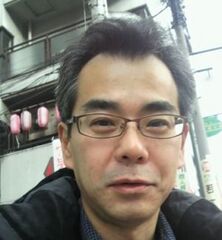Yutaka Sugano
From Sega Retro

|
| Yutaka Sugano |
|---|
| Employment history:
Divisions:
Sega Enterprises (1994 – 1999-07)
|
| Role(s): Designer |
This teeny-tiny article needs some work. You can help us by expanding it.
Yutaka Sugano (菅野 豊) is a former game designer and producer at Sega, known for designing Shinobi and Crack Down, and for producing several Sonic the Hedgehog games outside of Japan. He left Sega in 1999 with Naoto Ohshima and Yoji Ishii to become a part of Artoon. Following this company's disbandment in 2010, he is now the Vice President of Arzest, another video game development company.
Contents
Career
Sega
Yutaka Sugano graduated from university with a mining engineering degree, which was surprisingly useful in his video game career, as he has since compared it to the process of exploring a dungeon.[2] He submitted job applications to various companies, with Sega Enterprises the only video game company, which also happened to be his first choice.[2] He was hired as a game designer in 1986, and made his debut as an assistant game designer on Alex Kidd: The Lost Stars[2].
His most influential came a year later: Shinobi, for which he designed the gameplay mechanics, levels, bonus stages, layout of the user interface elements and the sequence of events during levels which create its difficulty scaling.[2]. Though he was not involved with further sequels, this smash hit spawned one of Sega's most prominent and most-imitated franchises.
Shortly after the release of Crack Down in 1989, Yutaka Sugano was transferred to Sega of America, leaving unfinished designs for the Sega System 18 arcade game Michael Jackson's Moonwalker in the hands of Roppyaku Tsurumi.[3] Sugano was then a producer at Sega Technical Institute, where he participated in the production of Sonic 2 and Sonic Spinball. He returned to Japan in 1994, mainly producing third party projects for the Sega Saturn, leveraging his experience in America to work with developers based outside of Japan, such as Maxis, Traveller's Tales and Tantalus Interactive.
After Sega
Production history
Games
- Alex Kidd: The Lost Stars (System 16; 1986) — Assistant Game Designer
- Shinobi (System 16; 1987) — Staff[4] (as Sugachan 26)
- Crack Down (System 24; 1989) — Planner[5]
- Michael Jackson's Moonwalker (System 18; 1990) — Original Design
- Sonic the Hedgehog Spinball (Mega Drive; 1993) — Producer[6]
- The Mansion of Hidden Souls (Saturn; 1994) — Producers[7]
- Gale Racer (Saturn; 1994) — Producer[8]
- Panzer Dragoon (Saturn; 1995) — Special thanks to[9] (as 菅野 豊)
- Panzer Dragoon (Saturn; 1995) — Special Thanks[10]
- Cyber Speedway (Saturn; 1995) — Producers[11]
- SimCity 2000 (Saturn; 1995) — Producer[12]
- Sonic 3D: Flickies' Island (Mega Drive; 1996) — Senior Producer[13]
- Sonic 3D: Flickies' Island (Mega Drive; 1996) — Producers (SOJ)[13]
- Panzer Dragoon (Windows PC; 1996) — Special Thanks
- Manx TT Super Bike (Saturn; 1997) — Producers[14]
- Sky Target (Saturn; 1997) — Senior Producer[15]
- Manx TT Super Bike (Windows PC; 1997) — Special Thanks To
- The House of the Dead (Saturn; 1998) — Special Thanks[16]
- The House of the Dead (Saturn; 1998) — Special Thanks To[17]
- Shoujo Kakumei Utena: Itsuka Kakumei Sareru Monogatari (Saturn; 1998) — プロデューサー[18] (as 菅野 豊)
- Sega Ages Galaxy Force II (Saturn; 1998) — Thanks to[19]
- Sonic Adventure (Dreamcast; 1998) — Software Support
- Sonic 3D: Flickies' Island (Saturn; 1996) — Senior Producer[20]
- Sonic 3D: Flickies' Island (Saturn; 1996) — Producers (SOJ)[20]
- Mario & Sonic at the Rio 2016 Olympic Games (Nintendo 3DS; 2016) — Producer
Music
- Gran Chaser (CD; 1995) — Original Game Produce
- Legend of Joe Musashi: Shinobi Music Collection (CD; 2009) — SPECIAL THANKS to[21]
Hardware
- Sega Dreamcast (Dreamcast; 1998)
References
- ↑ 1.0 1.1 1.2 1.3 1.4 1.5 https://archive.ph/FNO9l
- ↑ 2.0 2.1 2.2 2.3 2.4 2.5 2.6 https://www.memoriabit.com.br/exclusivo-entrevista-yutaka-sugano-produtor-de-shinobi/ (Wayback Machine: 2023-11-14 14:59)
- ↑ https://www.onemillionpower.com/astro-city-mini-and-game-design-part-1/
- ↑ File:Shinobi Arcade credits.pdf
- ↑ File:CrackDown BestSoldiers.png
- ↑ File:Sonic Spinball MD credits.pdf
- ↑ File:Shinsetsu Yumemi Yakata Saturn credits.pdf
- ↑ File:Galeracer_Saturn_JP_SSEnding.pdf
- ↑ File:Panzer Dragoon JP Saturn credits.pdf
- ↑ File:Panzer Dragoon US Saturn credits.pdf
- ↑ File:Cyber Speedway Saturn credits.pdf
- ↑ File:Simcity2000 Saturn JP SSCredits.pdf
- ↑ 13.0 13.1 File:Sonic 3D Blast MD credits.pdf
- ↑ File:Manx TT Saturn credits.pdf
- ↑ File:SkyTarget Saturn JP SSEnding.pdf
- ↑ File:House of the Dead Saturn credits.pdf
- ↑ File:Thotd sat us manual.pdf, page 26
- ↑ File:SKUIKSM_Saturn_JP_SSEnding.pdf
- ↑ File:Sega Ages Galaxy Force II Saturn credits.pdf
- ↑ 20.0 20.1 File:Sonic 3D Blast Saturn credits.pdf
- ↑ File:ShinobiMusicCollection CD JP Booklet.pdf, page 11